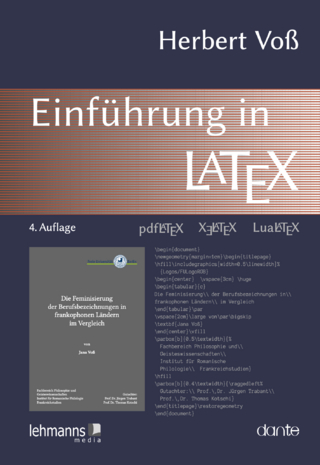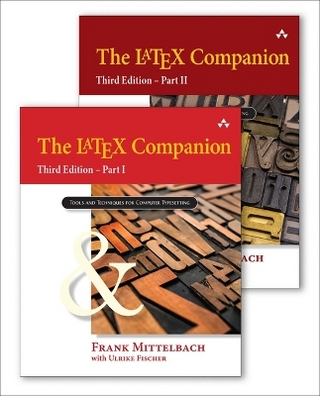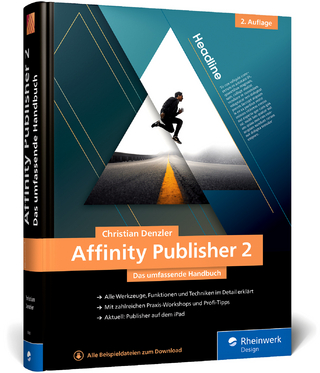
A Beginner’s Book of TEX
Springer-Verlag New York Inc.
978-0-387-97562-7 (ISBN)
- Titel ist leider vergriffen;
keine Neuauflage - Artikel merken
1: What is TEX.- 1.1 The birth of TEX.- 1.2 How TEX works.- 1.3 The good news and bad news about TEX.- 1.4 TEX who and what for?.- 1.5 TEX processing: an overview.- 1.6 Looking ahead.- 1.7 Creating a master file.- 1.8 Error messages.- 2: The characters of TEX.- 2.1 Characters that are special to TEX.- 2.2 Quotes.- 2.3 Ligatures and special characters.- 2.4 Accents.- 2.5 Two exercises.- 3: Groups and modes.- 3.1 Groups.- 3.2 Modes.- 3.3 For the aspiring wizard.- 4: The fonts TEX uses.- 4.1 TEX’s fonts.- 4.2 Preloaded fonts.- 4.3 Loading other fonts.- 4.4 A cornucopia of fonts.- 4.5 Scaling of fonts.- 4.6 Global scaling.- 4.7 For the aspiring wizard.- 4.8 Exercise.- 5: Spacing, glue and springs.- 5.1 Horizontal spacing.- 5.2 Vertical spacing.- 5.3 Glue, or, spaces that stretch and shrink.- 5.4 Springs.- 5.5 Spacing and breaks.- 5.6 Summaryof basic spacing commands.- 5.7 Spacing between paragraphs.- 5.8 More spring like creatures.- 5.9 Leaders in their full glory.- 5.10 For the experienced user.- 5.11 Examples.- 6: Paragraphs.- 6.1 Beginning and ending a paragraph.- 6.2 What’s in a paragraph?.- 6.3 Automatic indentation.- 6.4 Obeying lines.- 6.5 Left and right margins.- 6.6 Ragged margins.- 6.7 Quotations.- 6.8 Centering text.- 6.9 Series of items.- 6.10 More on hanging indentation.- 6.11 Paragraphs with fancy shapes.- 6.12 Footnotes.- 6.13 Twonew macros for the aspiring wizard.- 7: Page layout.- 7.1 Page layout in plain TEX.- 7.2 A more elaborate layout.- 7.3 The title page.- 7.4 Starting a fresh page and leaving a blank page.- 7.5 Placing a title.- 7.6 Choosing line and page breaks by hand.- 7.7 Floats.- 7.8 A complete example.- 7.9 Penalties: or, the carrot and the stick.- 8: Boxes.- 8.1 What is a box?.- 8.2 Putting boxes together.- 8.3 What goes in a box?.- 8.4 Creating a box: summary.- 8.5 Storing a box.- 8.6 The baseline.- 8.7 The dimensionsof a box.- 8.8 Some practical situations.- 8.9 Spacing between boxes.- 8.10 Rules.- 8.11 More practical examples.- 8.12 For the a spiring wizard.- 9: Alignments.- 9.1 The preamble, a.k.a. recipe.- 9.2 Simple alignments.- 9.3 Somepractical suggestions.- 9.4 Treating special cases.- 9.5 Excessivelywide entries.- 9.6 Inserting material betweenrows.- 9.7 Combining columns.- 9.8 Aligningdigits.- 9.9 Horizontal rules and spacing.- 9.10 Vertical rules.- 9.11 Braces and tables.- 9.12 Fixing the width of an alignment.- 9.13 Vertical alignments.- 10: Tabbing.- 10.1 Setting tabs.- 10.2 Centering.- 10.3 Choosing column widths.- 10.4 Equally spaced tabs.- 10.5 Clearing tabs.- 10.6 Tabs and rules.- 10.7 Tabs and springs.- 10.8 Typesetting code.- 10.9 Tabs and alignments: a comparison.- 11: Typesetting mathematics.- 11.1 Generalities.- 11.2 Math symbols.- 11.3 Fonts in math mode.- 11.4 Subscripts and superscripts.- 11.5 Accents.- 11.6 Spacing in math mode.- 11.7 The four styles.- 11.8 Function names.- 11.9 Fractions.- 11.10 Large operators and limits.- 11.11 Radicals.- 11.12 Horizontally extensible symbols.- 11.13 Vertically extensible symbols.- 11.14 Stacking up symbols.- 11.15 Combining relations.- 11.16 More custom-made symbols: limits.- 11.17 Phantoms.- 11.18 Displaying several formulas.- 11.19 Aligning several formulas.- 11.20 Labeling formulas.- 11.21 Matrices.- 11.22 Adjusting the spacing.- 11.23 Ellipses.- 11.24 Diagrams.- 12: TEX Programming.- 12.1 Generalities.- 12.2 Abbreviations and clones.- 12.3 Macros with arguments.- 12.4 Fine points of macro syntax.- 12.5 Category codes.- 12.6 Active characters.- 12.7 How TEX reads and stores your text.- 12.8 Registers.- 12.9 Conditionals.- 12.10 For the aspiring wizard.- 13: Dictionary and Index.
| Übersetzer | Silvio Levy |
|---|---|
| Vorwort | D. Foata |
| Zusatzinfo | 1 Illustrations, black and white; XII, 284 p. 1 illus. |
| Verlagsort | New York, NY |
| Sprache | englisch |
| Maße | 178 x 254 mm |
| Gewicht | 1160 g |
| Themenwelt | Kunst / Musik / Theater ► Design / Innenarchitektur / Mode |
| Informatik ► Grafik / Design ► Desktop Publishing / Typographie | |
| Mathematik / Informatik ► Informatik ► Theorie / Studium | |
| Naturwissenschaften ► Geowissenschaften ► Geologie | |
| ISBN-10 | 0-387-97562-4 / 0387975624 |
| ISBN-13 | 978-0-387-97562-7 / 9780387975627 |
| Zustand | Neuware |
| Haben Sie eine Frage zum Produkt? |
aus dem Bereich


